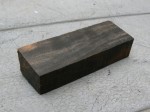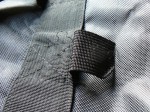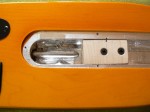After having used the Stagg for a while now, I noticed that the nut slots could be a bit deeper, mainly on the E and A strings. So digged up a business card as a distance gauge and some small files and decided to have a go at it.
The Stagg nut is made of plastic which is not the best nut material to be honest… But nevertheless working on it went fine but it turned out that business card thickness was just a bit too little on the E string. There is no buzz on the E string itself but when plucking the A string the E string “clacks” against the fingerboard. Which I find quite annoying… Or course this only occurs while playing pizz (I play mostly arco nowadays (started in an symphonic orchestra recently) but I have decided to have a go at making a new nut from ebony in the near future…
 So I have ordered a piece of ebony that was in my mail just yesterday. I showed it to my kids and they would not believe that wood would sink… So I proved to them that it actually does in a glass of water. Never thought a piece of wood could be educational!
So I have ordered a piece of ebony that was in my mail just yesterday. I showed it to my kids and they would not believe that wood would sink… So I proved to them that it actually does in a glass of water. Never thought a piece of wood could be educational!
In the near future I will try to make a new nut for the Stagg. I will document this process in this blogpost.
UPDATE
Contradictory to what I wrote earlier, I am NOT going to make a new nut in the future. The E string “clacking” has gone (or I have gotten used to it…) and the plastic nut works fine.
I am however going to make a new pickup for the Stagg as the stock ones do not work well when playing arco. But that is a whole different story….


















